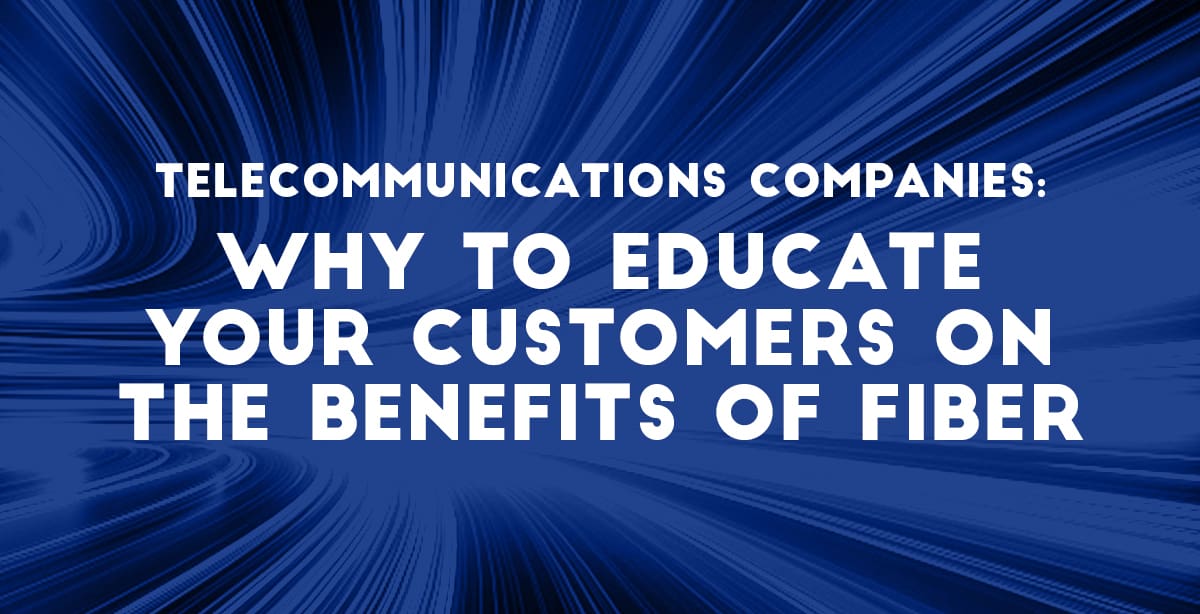
In the digital era we live in today, consumers are growing ever more reliant on their internet access. They use their connections to communicate, make purchases, facilitate learning, complete work assignments, seek out entertainment — and much, much more. And no matter the task or pastime, fiber-optic networks are providing the fastest speeds and the biggest bandwidths, upping tempos and adding efficiency for the internet users who leverage them.
For fiber providers, though, a common challenge related to their amped-up offerings can hamper sales efforts: Consumers are often unaware of fiber’s many benefits, and many don’t know what type of connection they have or even what their home’s internet speed is. In fact, according to past FCC research, up to 80% of consumers surveyed didn’t know what internet speed they purchased from their internet service providers (ISPs). As such, it’s clear that customers need to be better educated about the benefits of broadband — and that providers need to better communicate the advantages of fiber optics.
An array of advantages to communicate to your customers
The benefits of fiber, of course, are extensive. As today’s most sought-after method for transmitting data, fiber is not only fast, it’s also:
- Symmetrical: Fiber offers upload and download speeds that are equally fast, as opposed to the slow upload speeds many traditional connections deliver.
- Dedicated: Fiber users don’t have to share their connections with their neighbors, leaving no need to worry about slowdowns during peak usage times.
- Reliable: Fiber connections are less likely to be affected by power outages, severe weather and moisture than other types of internet connections.
- Future-proof: Because its glass-based composition allows fiber to transmit data at the speed of light, fiber-optic networks have yet to come anywhere close to having their capacity maxed out, and they promise to remain relevant for years to come.
- Sustainable: With lower energy-consumption levels, longer infrastructure life spans and less waste produced in their production, fiber networks are considered “greener” than other options.
Unfortunately, despite their many benefits, fiber-optic connections are outside the grasp of many Americans. In fact, according to a 2019 study commissioned by the Fiber Broadband Association, roughly 30% of U.S. households had access to fiber networks, and that share is expected to reach 50% by 2025 — still leaving half of American households without access.
Big upsides to future fiber investment
Of course, investing in fiber-network growth could bring a long list of benefits to more American homes and businesses. Consider these five important reasons that expanding fiber availability — particularly in the more rural areas of the United States — is a high priority that all stakeholders need to grasp:
- Education ” As the coronavirus pandemic has exhibited, remote learning can provide students with an essential connection to the classroom when schools must be closed for unforeseen reasons or when in-person instruction is otherwise not possible. And with fiber connections in place, communication and the flow of educational information can be faster and clearer — benefitting students, teachers, parents and communities as a whole.
- Teleworking ” Even before 2020 took telecommuting to all-new levels, the trend had already been set in motion by workers’ desire for more workplace flexibility and employers’ desire to boost employee retention via a better work-life balance. And with access to fiber connections, remote workers can be more productive and effective via benefits like faster file downloads and clearer videoconferences.
- Telehealth ” Telemedicine can add convenience by saving patients the hassle of traveling to a caregiver’s office and waiting for their appointment to begin once they arrive there. But can also help bridge the care-availability gap in rural communities where access to healthcare is limited. And of course, with the better, clearer connections that fiber provides, the telehealth experience gets a welcome boost.
- Economic development ” As internet connectivity becomes more and more vital to conducting business, areas without broadband availability are put at a disadvantage when it comes to attracting and retaining businesses. Alternatively, according to research, adding broadband access in rural communities can lift job growth there by 1.4% and boost the number of businesses in these areas by 1.2%.
- Precision agriculture ” Broadband availability can help farmers in rural areas tap into the benefits of precision agriculture. This practice can help boost crop yields and minimize environmental risks via the use of IT to gather, process and analyze a range of data related to plant and soil needs, then use this information to better inform agricultural decision-making.
Could your telecommunications brand use help educating your customers on the benefits of fiber in the home, in the workplace and in their communities? With a wealth of experience in the category, The Brandon Agency specializes in telecommunications marketing — and boasts expertise in a broad range of other mission-critical areas of marketing. Contact us today to learn how our team of marketing professionals can assist you!
By subscribing to our newsletter, you agree to our Privacy Policy.



